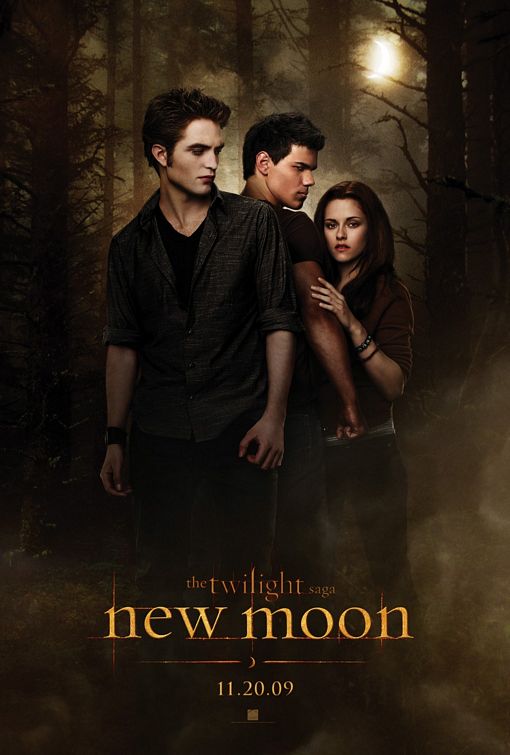 The first “Twilight” movie was a massive box office hit, making nearly $385 million worldwide. That's chump change to what its sequel, “The Twilight Saga: New Moon,” is likely to make. In just three days, “New Moon” earned $285 million worldwide. We've got a monster on our hands.
The first “Twilight” movie was a massive box office hit, making nearly $385 million worldwide. That's chump change to what its sequel, “The Twilight Saga: New Moon,” is likely to make. In just three days, “New Moon” earned $285 million worldwide. We've got a monster on our hands.“New Moon” continues the love story of Bella Swan (Kristen Stewart) with the vampire Edward Cullen (Robert Pattinson). Events early in the film convince Edward that Bella isn't safe in his world, and so he and his vampire family leave town.
The heartbroken Bella falls into a deep depression and is only able to pull herself out of it with the help of her friend Jacob (Taylor Lautner), who turns out to be a werewolf that must hunt and kill vampires. His clan has an uneasy truce with the Cullen family.
A chain of events sends Bella to Italy to save a suicidal Edward from sacrificing himself to the Volturi, a sort of vampire royalty.
It is easy to see the appeal of the “Twilight” series to teen and tween girls. Bella not only has the obsessive love of one gorgeous supernatural being, but two — and girls can get vicarious thrills from the love triangle.
My biggest problem with the series is that Bella sends the wrong message to girls.
She's is selfish, self-absorbed, whiny and clingy. Bella doesn't have an arc in which she grows out of these traits; if anything they get worse as the series goes on. She defines herself by being with Edward and then, when that temporarily isn't an option, defines herself by Jacob.
“Twilight” was actually a reasonably well-written book. It was well paced and had a distinct voice. Author Stephanie Meyers doesn't sustain the pacing throughout the rest of the series, which becomes meandering and redundant.
Screenwriter Melissa Rosenberg missed the mark in her adaptation of “Twilight” and accentuated all the wrong things, namely the longing stares and overly dramatic declarations of love. In “New Moon” her adaptation is more focused and she removes a lot of Bella's self-loathing. There's still plenty of Bella's sorrow on screen, but not nearly as much as in the book, which says something about the book.
“New Moon,” at least as a film, is a step up from “Twilight.” There's still much of the emotional sameness that plagued “Twilight,” but director Chris Weitz (“The Golden Compass”) is more of a filmmaker than “Twilight” director Catherine Hardwicke. He manages to sneak in at least one visually poetic moment in which we see the passage of three months in a matter of moments.
Weitz also nicely visualizes when Bella has visions of Edward, and the climatic sequence in Italy, though rushed, is visually stunning.
The acting leaves something to be desired. Stewart and Pattinson play everything on one note of pained pining. Even before their breakup there seems to be no joy in there relationship. Perhaps intense brooding is more romantic.
Lautner is a bit better as Jacob. He brings a cheerful and jovial energy to the character that helps make parts of the film more palatable. There's a funny scene in which Bella takes Jacob and another friend (Michael Welch) to the movies. This scene, more so than any other, captures what being a teen is like. There are other brief moments when Jacob is goofing around with friends that approximate real teen interaction.
Unfortunately, when Lautner goes wolf midway through the movie he becomes just as serious and somber as Stewart and Pattinson. Why is everything so dire for these characters?
The best performance comes from Michael Sheen (“Frost/Nixon”) as the head of Volturi. He is an odd mixture of menacing and playful. Dakota Fanning briefly appears as a sinister member of the Volturi clan and does a good job playing against her precocious persona. Billy Burke as Bella's dad also has nice moments both tender and funny.
The movie ends with an abrupt cliffhanger, but fear not: The next film is only a few months away. “The Twilight Saga: Eclipse” is due out June 30, 2010. I'm sure the lines are already beginning.
 Director Robert Zemeckis brings his obsession with motion capture animation technology to Charles Dickens' beloved holiday classic “A Christmas Carol,” a story that strikes such a resonate cord that even if you've heard it a 100 times it still as the power to move.
Director Robert Zemeckis brings his obsession with motion capture animation technology to Charles Dickens' beloved holiday classic “A Christmas Carol,” a story that strikes such a resonate cord that even if you've heard it a 100 times it still as the power to move. With an attention grabbing name like “The Men Who Stare at Goats,” the latest George Clooney-produced film has an advantage over the competition: Your interest is piqued, you want to know more. Thankfully, the film, an offbeat military comedy, earns the interest its name garners.
With an attention grabbing name like “The Men Who Stare at Goats,” the latest George Clooney-produced film has an advantage over the competition: Your interest is piqued, you want to know more. Thankfully, the film, an offbeat military comedy, earns the interest its name garners. Over the last decade, Michael Jackson was more known for his bizarre, headline-making behavior than his talent as a performer. Thankful, the documentary “This Is It” is a powerful and immensely entertaining reminder of how extraordinarily talented Michael Jackson truly was.
Over the last decade, Michael Jackson was more known for his bizarre, headline-making behavior than his talent as a performer. Thankful, the documentary “This Is It” is a powerful and immensely entertaining reminder of how extraordinarily talented Michael Jackson truly was.